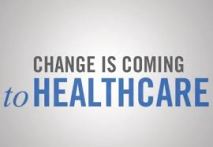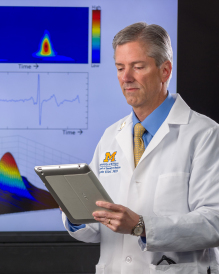With the ONC’s recent release of their 10-year interoperability vision, it might seem like the industry is starting to make things easier for clinicians. In reality, 2015 is starting off to be one of the worst times ever to be a physician. Interoperability is a critical issue to support a transition from fee-for-service to value-based care. Physicians will eventually be reimbursed around their ability to impact clinical outcomes, so the need for clinically relevant information at their fingertips is mission critical.
Tag Archives: clinicians
Today’s Pressure Breeds Tomorrow’s Solutions
It is no secret that health systems are under intense pressure to deliver better outcomes at lower costs, and standardizing acute care workflow will only carry providers so far. Truly moving the needle on cost and outcomes will require a fundamental redesign in care delivery; otherwise, health systems may well find themselves left out. Care keeps shifting to environments in which hospitals have less influence: what was once critical care can now be managed in an in-patient unit; what was once in the hospital is now in an office; what was once in the office is now at home.
Creating a Friendly Environment for Adoption of Clinical Decision Support
In recent years, our ability to stream large amounts of data in real-time has improved dramatically. This enhancement can transform how clinicians offer care by sourcing unprecedented opportunities for clinical decision support. However, the capability to process, store, and display data in and of itself does not transform care. Rather, it is how the clinicians adopt and apply decision support that will make all the difference to patients. However, the current environment must be altered to create a clinical decision support-friendly climate.
Embracing Security Challenges
 Over the past year, the perception of mobile technology in healthcare has changed dramatically. mHealth is now being recognized as a tool that can help address the challenges our healthcare system is facing, including a shortage of caregivers, an influx of newly insured patients, decreased reimbursements and readmission penalties. Historically, there have always been barriers that kept hospitals from making the leap to mobility – lack of infrastructure, costs, or the fear of security breaches, among other reasons. Yet as mobile technology becomes deeply ingrained in our day-to-day work and social lives, healthcare is following suit and migrating toward mobility as a component of care delivery.
Over the past year, the perception of mobile technology in healthcare has changed dramatically. mHealth is now being recognized as a tool that can help address the challenges our healthcare system is facing, including a shortage of caregivers, an influx of newly insured patients, decreased reimbursements and readmission penalties. Historically, there have always been barriers that kept hospitals from making the leap to mobility – lack of infrastructure, costs, or the fear of security breaches, among other reasons. Yet as mobile technology becomes deeply ingrained in our day-to-day work and social lives, healthcare is following suit and migrating toward mobility as a component of care delivery.
However, concerns about security remain at the forefront. According to data from the Department of Health and Human Services (HHS), more than 41 million people have had their protected health information compromised in a reportable HIPAA privacy or security breach. Additional data from the 2014 Healthcare Breach Report from Bitglass suggests that 68 percent of all healthcare data breaches are due to device theft or loss and 48 percent of breaches involve a laptop, desktop or mobile device.
HIPAA on the Hill
 The pace of mHealth innovation shows no signs of slowing down. New technologies are not only improving the lives of patients, but also empowering clinicians. However, healthcare is a highly regulated space dominated by major vendors, and it is vital that the regulatory environment keep up with the changing world. Specifically, it’s time for the Department of Health and Human Services (HHS) to take a fresh look at the Health Insurance Portability and Accountability Act (HIPAA) to ensure it better fits today’s mobile world.
The pace of mHealth innovation shows no signs of slowing down. New technologies are not only improving the lives of patients, but also empowering clinicians. However, healthcare is a highly regulated space dominated by major vendors, and it is vital that the regulatory environment keep up with the changing world. Specifically, it’s time for the Department of Health and Human Services (HHS) to take a fresh look at the Health Insurance Portability and Accountability Act (HIPAA) to ensure it better fits today’s mobile world.
Current HIPAA guidelines – while critical – need to be revised to support smaller companies that can transform the space. Leading app developers across the industry are working together to seek clearer guidelines that will encourage innovation. The App Association recently joined with AirStrip, CareSync, and other mHealth companies urging government representatives to look at this issue so we can better align our practices with theirs and together work towards the goal of improved patient care.
What stage of “Meaningful Interoperability” are you?
 The Office of the National Coordinator for Health Information Technology (ONC) just released what it calls “A 10-Year Vision to Achieve an Interoperable Health IT Infrastructure.” The directive generating the most attention calls for “a common set of electronic clinical information…at the nationwide level by the end of 2017.” According to ONC, the common data set would consist of about 20 basic elements, such as patient demographics and lab test results.
The Office of the National Coordinator for Health Information Technology (ONC) just released what it calls “A 10-Year Vision to Achieve an Interoperable Health IT Infrastructure.” The directive generating the most attention calls for “a common set of electronic clinical information…at the nationwide level by the end of 2017.” According to ONC, the common data set would consist of about 20 basic elements, such as patient demographics and lab test results.
At first blush, the ONC directive is a small step in the right direction, but sets the bar awfully low. Rest assured that vendors will consider 20 basic elements the maximum data set, not the minimum. A more effective approach would, for example, specify vocabularies (LOINC, RxNORM), document types (JSON, XML) and transport mechanisms (HTTPS or other TLS) to be used when sending or receiving data instead of focusing on the data elements themselves.
Future of Health Care: Keeping the Patients in Mind
 The key to successful health care technology is making sure it improves both the patient experience and the quality of care. While technology is sometimes seen as a barrier to human connection and interaction, the right tools can transform the health care experience for the patient. At Dignity Health, our focus for 2015 is centered on making population health a reality by looking toward the ambulatory side of care. The mobility strategy we put in place in 2014 is enabling us to empower our providers and care teams with telehealth solutions so they can have alternate ways to connect with and care for their patients.
The key to successful health care technology is making sure it improves both the patient experience and the quality of care. While technology is sometimes seen as a barrier to human connection and interaction, the right tools can transform the health care experience for the patient. At Dignity Health, our focus for 2015 is centered on making population health a reality by looking toward the ambulatory side of care. The mobility strategy we put in place in 2014 is enabling us to empower our providers and care teams with telehealth solutions so they can have alternate ways to connect with and care for their patients.
Harnessing the Power of Big Data with Digital Health Partnerships
 In today’s digital world, electronic patient data is growing exponentially and moving faster than healthcare organizations can imagine. At the same time, clinicians suffer from information overload, and high-volume and increasingly complex clinical patient loads, alongside dwindling time and resources.
In today’s digital world, electronic patient data is growing exponentially and moving faster than healthcare organizations can imagine. At the same time, clinicians suffer from information overload, and high-volume and increasingly complex clinical patient loads, alongside dwindling time and resources.
Now more than ever, the pressure is building to harness the power of big data and digital technologies to help clinicians make faster, patient-centric decisions that increase quality of care and enhance health outcomes all while decreasing costs.
The Evolution of Health IT
Health IT is often considered a silent partner in healthcare – not seen by patients, but a critical part of the system. As we celebrate National Health IT Week, it’s important to realize that although health IT already has a long history, the constant and rapid evolution of this space continues to transform the market. Information has been collected and stored for years, but the promise of clinical decision support has us at the cusp of all this information becoming valuable in new and innovative ways.
Just a decade ago, I was documenting patient encounters in paper charts. Although the transition to electronic medical records (EMRs) has been perceived as slow, in the grand scheme of medicine it actually happened almost overnight. These systems were not designed with our continuously changing workflow in mind, with user interfaces and workflows that aligned to our practices. They served as repositories for patient information, but did little else. In fact, our workflow changed to support the EMR, sometimes to the detriment of the patient. Instead of focusing directly on the patient, we often must split our time and attention between the patient and the computer terminal.
Staying Ahead in a Technology-Driven Field
Since patient care and well-being is at the center of Rockdale’s mission, attracting the best and brightest clinicians in the region is an important effort for us. Part of distinguishing ourselves from our competitors is providing the resources and advanced technological support clinicians want. In fact, to support this shift, we formed the Information Technology Physician Engagement Group in 2013 to identify exactly what were the technology priorities for our physicians:
- Improved cellular service
- Improved physician Wi-Fi
- Single sign-on access
- Mobile technology for better efficiency
